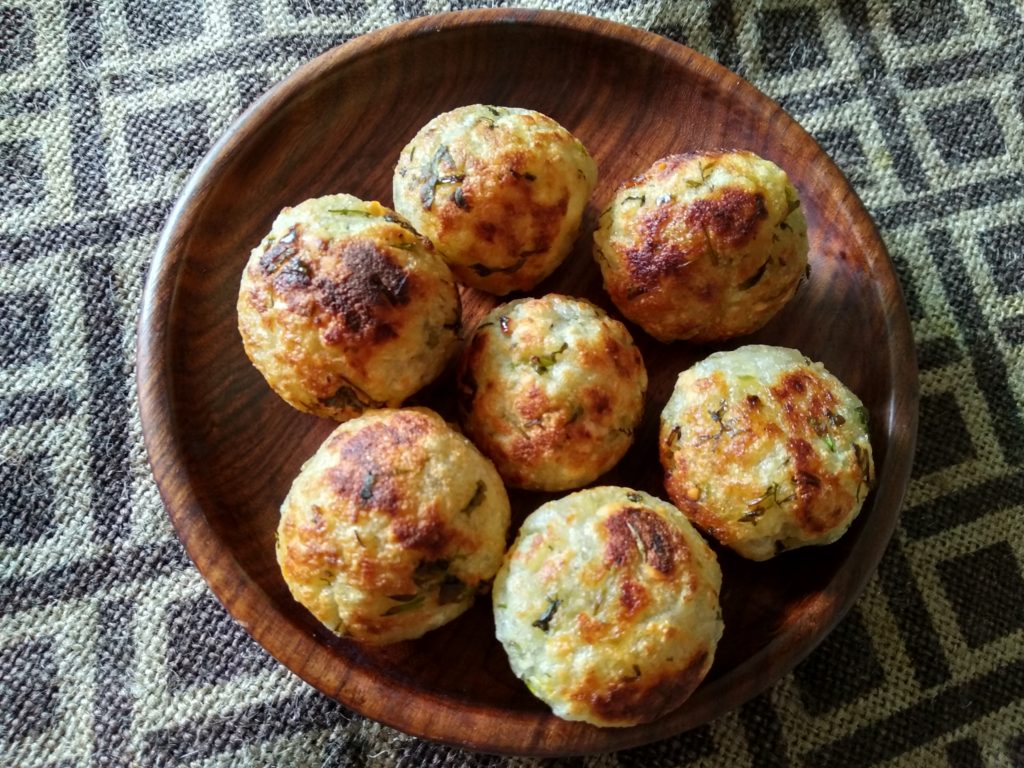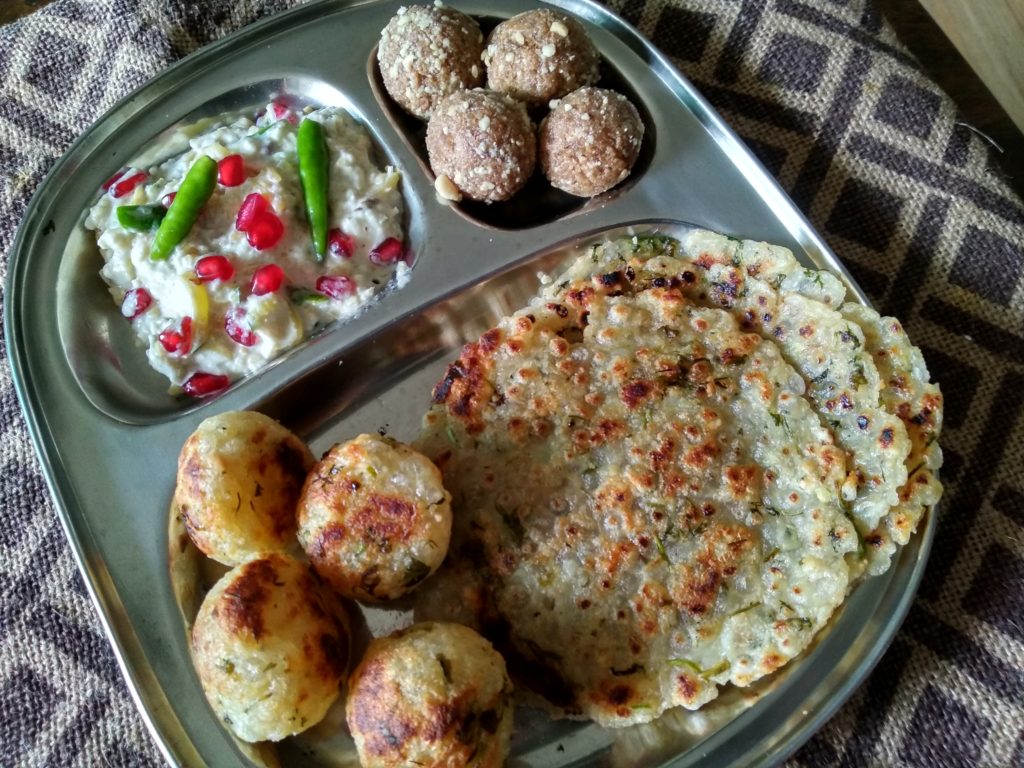
09 Oct Navratri recipes Day 1 / Thali for Day 1
Here is Thali for Navratri recipes day 1
Navratri is celebrated to worship the divine forms of Goddesses Durga (first 3 days), Lakshmi (next 3 days) and Saraswathi (last 3 days). These 9 days are supposed to be auspicious period for Hindus. In Maharashtra, Gujarat and some North Indian states, many people observe fast during the 9 days as offerings to these deities. Navratri fasting is very special with many do’s and dont’s. Keeping all these rules in mind, I have developed different recipes for different days of Navratri. These are fasting recipes that can make your fasting interesting.
This Thali for Day 1 has Sabudana Thalipeeth, Pumpkin Pomegranate Raita & Coconut Ladoo
| Sabudana Thalipeeth | Pumpkin Pomegranate Raita | Coconut Ladoo |
|---|---|---|
| Ingredients: ½ cup Sabudana (sago / javvarisi / sabakki) ½ cup boiled and mashed potato ¼ cup coarsely ground roasted peanuts 2 green chillies finely chopped Finely chopped coriander leaves 1 tsp lemon juice 1/8 tsp jaggery powder Rock salt to taste Oil / ghee for making thalipeeth Directions: 1. Soak the sago for minimum 5 hrs / overnight with the water 1” above the pearls. The soaking time differs due to quality of Sabudana. The Sabudana should be soft. The trick is to check if it mashes effortlessly when you press one pearl between your fingers. Drain excess water if any thoroughly. 2. Add all other ingredients and mix well. 3. The dough should be soft. Make medium lemon sized balls. 4. Heat a heavy bottomed tawa. 5. Take a plastic / baking sheet and slightly grease the centre. Place the ball on the greased portion and start flattening with hands. Wet your hands if necessary to spread the dough. Make fairly thin rounds and make 2 or 3 holes. 6. When the tawa becomes hot, gently place the sheet upside down and slowly peel off the sheet. Alternately, you can place the sheet upside down in your palm and peel off the sheet with the other hand and then place the thalipeeth gently on the tawa. Drizzle oil around if need be. 7. Cook till both sides become brown. Makes 8 to 9 thalipeeth | Ingredients: 2 tablespoon coarsely ground roasted peanut ¼ cup pomegranate 2 tablespoon grated fresh coconut Rock Salt to taste ¼ cup thick beaten curd (groundnut curd) 1 tsp oil ½ cup finely grated red pumpkin (kaddu) 1 green chilli slit ½ tsp cumin seeds Directions: 1. Heat 1 tsp oil and add cumin 2. Let the cumin splutter. And add slit green chilli and grated pumpkin. Sauté for few minutes till pumpkin becomes soft but remains crunchy. Remove in a bowl 3. Add first 4 ingredients and mix well 4. Finally add the beaten curd and mix. . | Ingredients: ½ cup freshly grated coconut ¼ cup jaggery powder 2 tablespoon cashew powder (preferably powdered till it leaves some oil) 2 tablespoon Rajgira flour / sama flour Pinch of cardamom powder Directions: 1. Dry roast Rajgira / sama flour till it gives a nice aroma. Do not over roast. Remove and keep in a bowl. 2. Heat coconut and jaggery powder and boil till they blend well. 3. Add cashew powder & roasted flour to thicken. Add cardamom powder. 4. Remove from heat and cool. 5. Grease your palm and make small ladoos. 6. Add more Rajgira flour if need be if the mixture in thin. It should be thick enough to roll between palms. Roll in peanut powder (optional). Makes 8 ladoos |
Traditionally Vrat recipes use ghee or groundnut oil. By default ghee is avoided, being a dairy free site.
Variation:
From the thalipeeth dough, remove half and make lemon sized balls. Heat an Appe pan, brush the moulds with oil and cook the vadas on slow fire. Keep turning till all sides brown equally. This is a better option for Sabudana Vada which requires to be deep fried and consumes lot of oil. These vadas can be kept an option for snack.
From the given ingredients for Thalipeeth, I got 4 thalipeeth and 7 Vadas.


The above food list is a generic one. You are at liberty to follow your family traditions.
Tips:
1. Do not starve yourself. Starving creates craving and we end up with over eating. Dry fruits and nuts can be had in moderation to avoid starving.
2. Consuming fresh fruits, fruit juices, coconut water, lime / kokum juice, etc helps in satiating the hunger and keeping the body hydrated.
3. Most important thing to remember during these festivals is to keep our hearts pure. By observing fast we try to cleanse our body. It is equally important to cleanse our mind & hearts too. Removing negative thoughts and directing our energies towards positive & right actions, help cleanse the mind & hearts.




Padmaja Narendran
Posted at 13:02h, 09 OctoberA very happy and blessed Navarathri to your family, Rama Akka..
Definitely this recipe, I will do.
With thanks and hugs,
Padmaja N.
ramag
Posted at 16:05h, 09 OctoberThank you Padmaja. Hugs to you too. Love
Paresh Rathod
Posted at 00:11h, 27 OctoberHello, First of all, Your work is very useful for me. And Your Article information about seo-. Keep it up and Thank you very much.:)
ramag
Posted at 13:36h, 21 JanuaryHello,
Sorry for the late response. Due to some personal reasons, I couldn’t log in all these days.
Thanks for your comments. Happy you liked the page. Will be posting more such recipes from now on.
Rgds